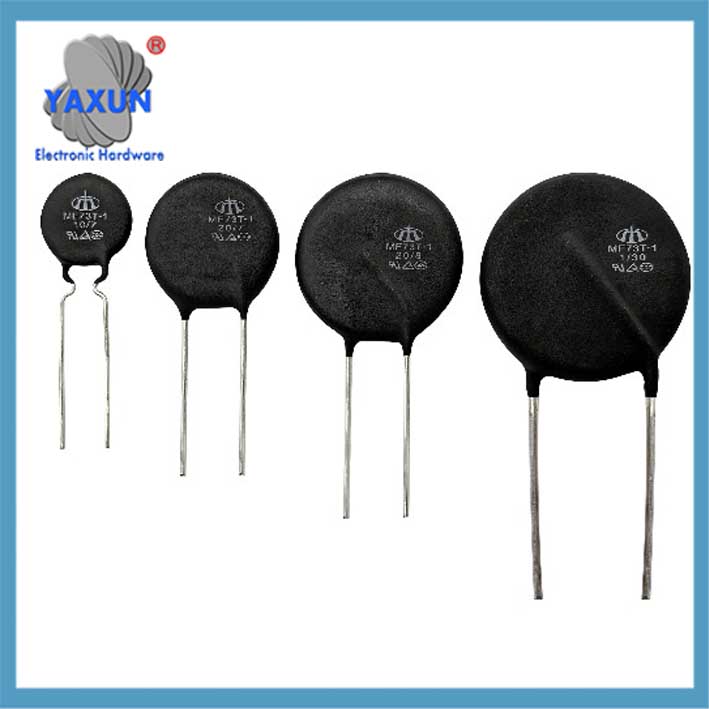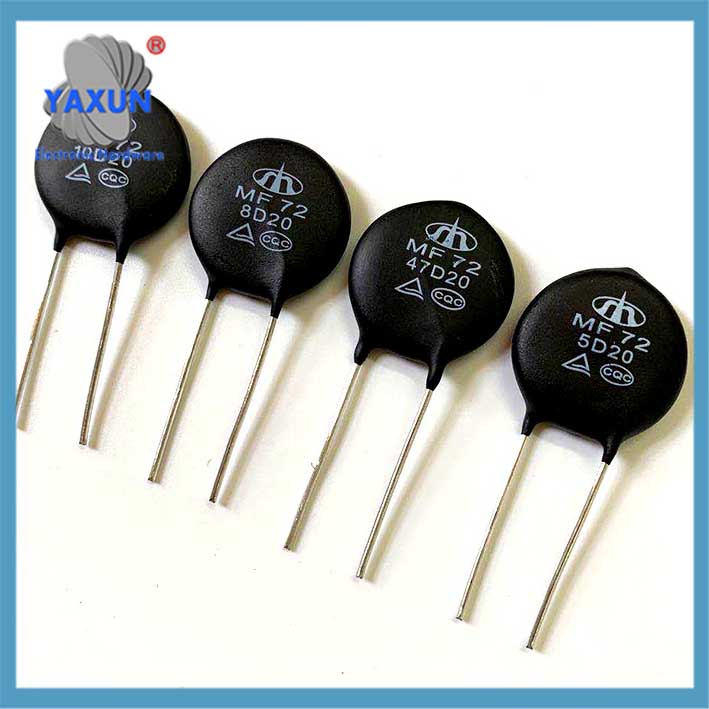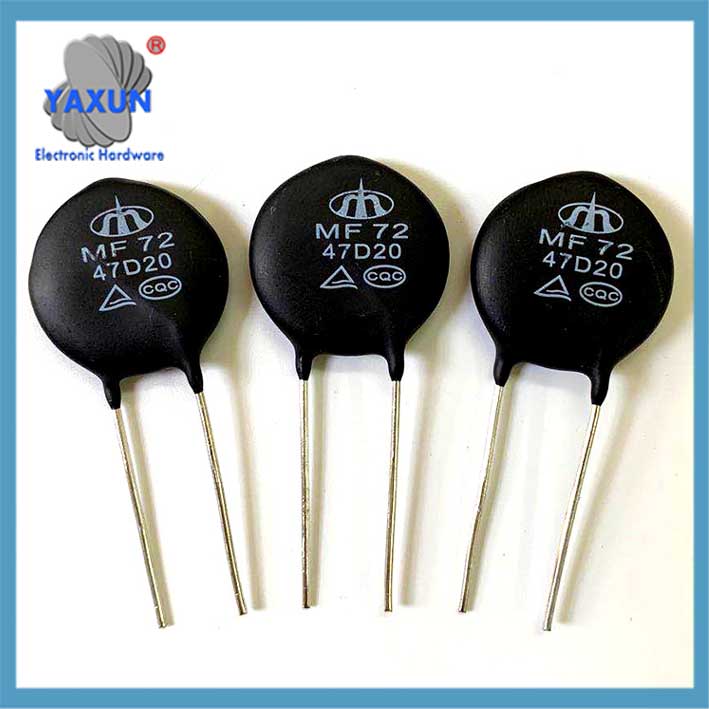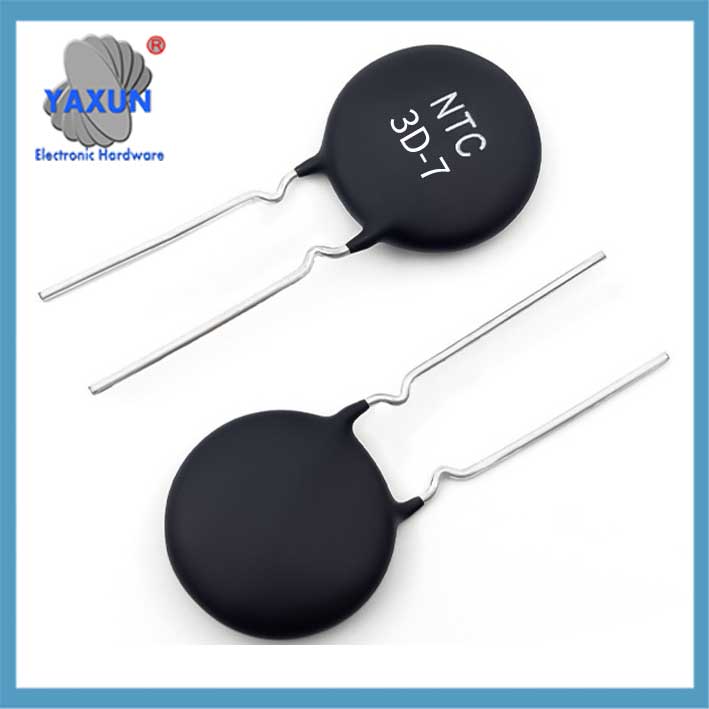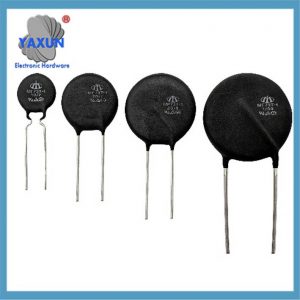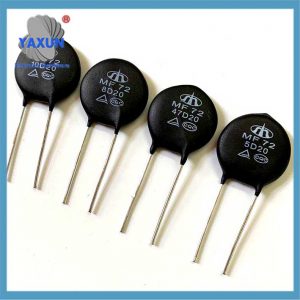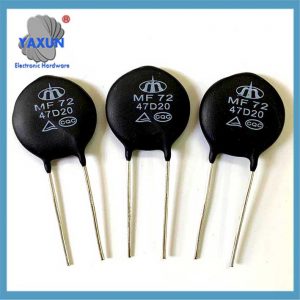Kategorie produktu
- Tepelná pojistka 32
- Pojistky povrchu 12
- Termistor 36
- Držák pojistky na montáž PCB 27
- Kabelový svazek 6
- Držáky pojistek 17
- termostat 50
- Elektrická pojistka 24
- Senzor teploty automobilů 7
- Jistič tepelného obvodu 22
- Pojistka držeče krabice 36
- Teplotní senzor 75
- Tepelný spínač 68
- Pojistka automobilu 20
- Přišroubujte pojistky 8
Značky produktů
Aplikace a výběr energetických termistorů
Co je to power termistor? Power Thermistor, také známý jako omezovač proudu Power NTC nebo Inrush, je součástí určené k potlačení převáděcích proudů v elektrických obvodech. Využívá samohlní charakteristiku negativního koeficientu teploty (NTC) Termistor omezit vysoké proudy, které mohou narůstat, když je obvod zapnutý.
Výkonový termistor (převážně záporný teplotní koeficient typu NTC) je klíčovou součástí pro potlačení rázového proudu v elektronických obvodech. Jeho hlavní parametry, body výběru a scénáře aplikace jsou následující:
I. Základní funkce a principy
Potlačení rázového proudu
V okamžiku spuštění napájení, hodnota odporu NTC zapojená do série ve vstupním obvodu je vysoká, který může omezit špičkový proud; po zapnutí napájení, odpor vlivem tepla rychle klesá (spotřebu energie lze ignorovat), zajištění stabilního provozu následných okruhů.
Negativní teplotní charakteristiky
Hodnota odporu exponenciálně klesá s rostoucí teplotou: R(T)=R0⋅eB⋅(1T-1T0)R(T)=R0⋅eB⋅(T1–T01) (R0R0 je hodnota odporu při 25℃, BB je materiálová konstanta).
Jak to funguje:
Vysoký počáteční odpor:
Při prvním připojení napájení, výkonový termistor má vysoký odpor, který omezuje počáteční zapínací proud.
Vlastní ohřev:
Jak proud protéká termistorem, vytváří teplo, způsobí snížení jeho odolnosti.
Snížení odporu:
Snížení odporu umožňuje obvodu odebírat potřebný provozní proud bez počátečního rázu.
Výhody:
Chrání zařízení:
Omezením zapínacího proudu, výkonové termostaty zabraňují poškození citlivých součástí a zařízení.
Snižuje ztrátu energie:
Snížení odporu samozahříváním snižuje ztráty výkonu ve srovnání s použitím pevného odporu.
Úspory energie:
Snížení ztráty energie může vést k úsporám energie v aplikacích, jako jsou spínané zdroje napájení a další elektrická zařízení.
Ii. Klíčové parametry a body výběru
| Parametry | Význam definice a výběru | Typická hodnota/rozsah |
| Jmenovitý odpor nulového výkonu (R25) | Jmenovitý odpor při 5°C určuje počáteční schopnost potlačení přepětí. Výpočtový vzorec: R25≈U2⋅IsurgeR25≈2⋅IsurgeU (UU je vstupní napětí, IsurgeIsurge je rázový proud) | Běžně používaný 2,5Ω, 5Ó, 10Ω±(15-30)% |
| Maximální ustálený proud | Proud, který lze udržet po dlouhou dobu při 25 ℃, musí být větší než pracovní proud obvodu | V závislosti na modelu 0,5A~desítky ampér |
| Zbytkový odpor | Minimální hodnota odporu při vysoké teplotě (například 100 ℃), ovlivňující běžnou spotřebu energie obvodu | Asi 1/10~1/20 z R25 |
| B hodnota | Materiálová stálost (měřeno při 25℃~50℃), určuje sklon křivky odpor-teplota; vysoká hodnota B reaguje rychle, ale má vysoké náklady | 2000K~6000K |
| Tepelná časová konstanta | Index rychlosti odezvy, typ náplasti (jako je SMD) může dosáhnout sekund | Skleněné těsnění/typ smaltovaného drátu asi 10~60 sekund |
Poznámka: Příklad označení modelu MF72-10D-9:
10: R25=10Ω.
D: Balení disků
9: 9průměr mm;
Iii. Typické scénáře aplikací
Napájecí zařízení: Potlačení vstupního přepětí spínaného zdroje, UPS, adaptér;
Systém osvětlení: Protinárazová ochrana LED driveru, zátěž, rozvodná skříň osvětlení;
Industriální vybavení: Startování motoru, průmyslové napájení, lékařský nástroj;
Household spotřebiče: Klimatizace, ochrana proti spuštění kompresoru chladničky;
IV. Průvodce výběrem a vyhýbáním se
CURRENT SPORTY
Maximální ustálený proud musí být větší než 1.5 krát skutečný pracovní proud, aby se předešlo trvalému zahřívání a selhání.
Návrh odvodu tepla
Ve scénářích s vysokým výkonem, aby se zabránilo nadměrnému nárůstu teploty, který způsobí nedostatečný zbytkový odpor, je vyžadován dostatečný odstup nebo pomocný odvod tepla.
Extrémní teplota
Rozsah provozních teplot je obecně -55℃~+125℃. Skleněné modely (odolný do 150 ℃) jsou preferovány v prostředí s vysokou teplotou.
PROTI. Porovnání balení a výkonu
| Typ balíčku |
Výhody | Použitelné scénáře |
| Epoxidová pryskyřice | Nízká cena, dobrá vodotěsnost | Domácí spotřebiče, běžné napájecí zdroje |
| Skleněný obal | Vysoká teplotní odolnost (>150℃), Rychlá reakce | Průmyslová zařízení, automobilová elektronika |
| Typ povrchové montáže (SMD) | Malá velikost, vhodné pro PCB s vysokou hustotou | Kompaktní napájecí modul |
Tip: Buďte opatrní při častém přepínání – NTC může ztratit schopnost potlačení přepětí, když je nedostatečné chlazení nedostatečné. V tuto chvíli, lze připojit paralelní reléový bypass.
Kontaktujte nás
Čekání na váš e -mail, Odpovíme vám uvnitř 12 hodiny s cennými informacemi, které jste potřebovali.
 English
English Afrikaans
Afrikaans العربية
العربية বাংলা
বাংলা bosanski jezik
bosanski jezik Български
Български Català
Català 粤语
粤语 中文(简体)
中文(简体) 中文(漢字)
中文(漢字) Hrvatski
Hrvatski Čeština
Čeština Nederlands
Nederlands Eesti keel
Eesti keel Suomi
Suomi Français
Français Deutsch
Deutsch Ελληνικά
Ελληνικά हिन्दी; हिंदी
हिन्दी; हिंदी Magyar
Magyar Bahasa Indonesia
Bahasa Indonesia Italiano
Italiano 日本語
日本語 한국어
한국어 Latviešu valoda
Latviešu valoda Lietuvių kalba
Lietuvių kalba македонски јазик
македонски јазик Bahasa Melayu
Bahasa Melayu Norsk
Norsk پارسی
پارسی Polski
Polski Português
Português Română
Română Русский
Русский Cрпски језик
Cрпски језик Slovenčina
Slovenčina Slovenščina
Slovenščina Español
Español Svenska
Svenska ภาษาไทย
ภาษาไทย Türkçe
Türkçe Українська
Українська اردو
اردو Tiếng Việt
Tiếng Việt
